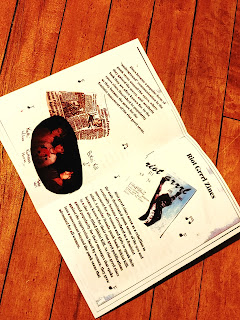Zines Talk!: How Visualization Can Support Student Understanding
Zines Talk!: How Visualization Can Support Student Understanding
As a visual culmination for the work I have done with zines as a mode for unlocking adolescent literacy, I have created my very own zine titled Zines Talk. As I reflected on the texts I curated for a potential zine-based unit in my future teaching, I noticed there was a glaring lack of full, print-based zines. In fact, the only zine I had included until in the teaching of this unit was meant to scaffold students’ understanding of another non-zine text. In response to this, I decided to create my own print-based zine about two significant publication topics that created vast communities in the history of zines and the endless potential zines have to create more communities.
When I began to conceptualize this zine, I decided I wanted to focus on real, historical movements that have been made through the use of zines in order to express to students the relevance zines have in building community and spreading activism. As a future educator, it is important to understand that “students are often eager to find solutions to problems they experience and are capable of coming up with creative, developmentally appropriate solutions.” (Kawai & Cody 25). I believe demonstrating past examples where zines were used to respond to problems people have experienced can serve as a model for students and hopefully inspire them to channel their activism into zines as a potential solution. With this focus in mind, I set out to create my own zine with the intent of inspiring the creation of many more.
In beginning research for creating my zine, I came across an article titled “A Brief History of Zines,” which discussed several movements that have been made through zines. This article did a nice job discussing some movements that were fueled by zines that I wanted to include in my final zine. As I was reading the article, which did not include many content-related images, I found myself using a lot of the visualization techniques we’ve discussed in class. For example, when reading about the award given for Best Fanzine I immediately started to picture a shiny, big award that could be earned by creating a zine. However, I know that not all readers are able to visualize in this way, as reluctant readers often have “limited vocabulary, little background knowledge about many topics, lack of understanding of the relationships represented in the language of the text, and lack of awareness that attempting to visualize what is happening might be helpful.” (Hibbing 758) With this understanding of my students potentially not having the awareness to visualize, I set out to select images referenced in the text that would enhance my students’ understanding of the text and increase their engagement. I included the image of the Best Fanzine award not only because it was an image referenced in the text, but also because I believed my students would be interested in the glamor and prestige of an award given for a zine. The photos of zine cover art was another attempt to engage my students as they could see the large variety of zines and how the cover art and styles change from sci-fi zines to riot grrrl zines and modern day zines. Noting these differences in the style of a variety of zines was something I had not considered when reading the article and the selection of the images is one way that my knowledge of these various zine types was deepened.
A final takeaway I gained from this zine project was the importance in using visualization to scaffold students’ understanding and increase accessibility. If I had just assigned my students the article my zine was based on, they would have little appreciation for the zines that were created in each movement and the people they inspired, both of which I was able to add through including pictures in my visualization. I also became aware of how my ability to visualize while reading is not necessarily an ability shared by my students; yet, I can support my students by providing visuals that I select to support my students as they are building their own visualization skills over time.
Works Cited
Arnold, Chloe. “A Brief History of Zines.” Mental Floss, Mental Floss, 19 Nov. 2016, https://www.mentalfloss.com/article/88911/brief-history-zines.
Kawai, Roi, and Jennifer Cody. “Civic Zines: Writing, Discussing, and Doing Citenzinship.” Social Studies and the Young Learner, 2015, pp. 22–25.
Nielsen Hibbing, Anne, and Joan L. Rankin-Erickson. “A Picture Is Worth a Thousand Words: Using Visual Images to Improve Comprehension for Middle School Struggling Readers.” The Reading Teacher, vol. 56, no. 8, May 2003, pp. 758–770.







Comments
Post a Comment